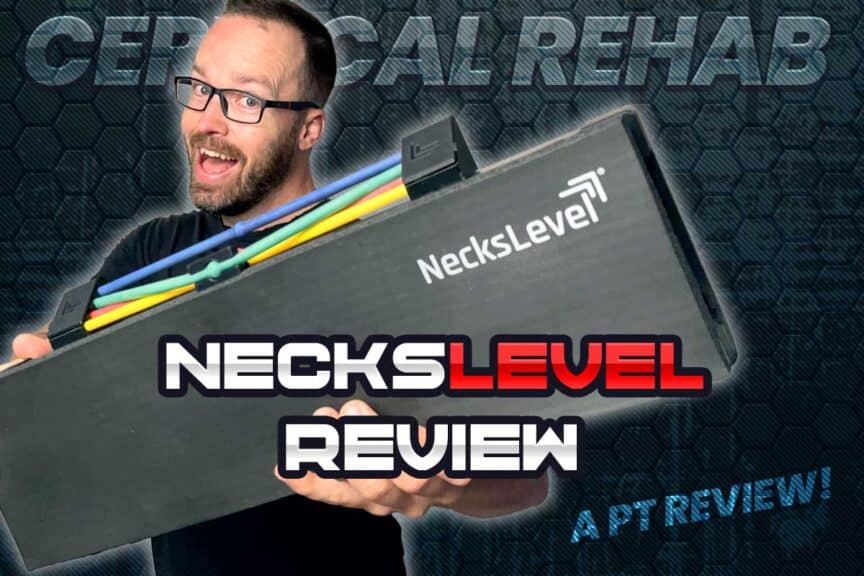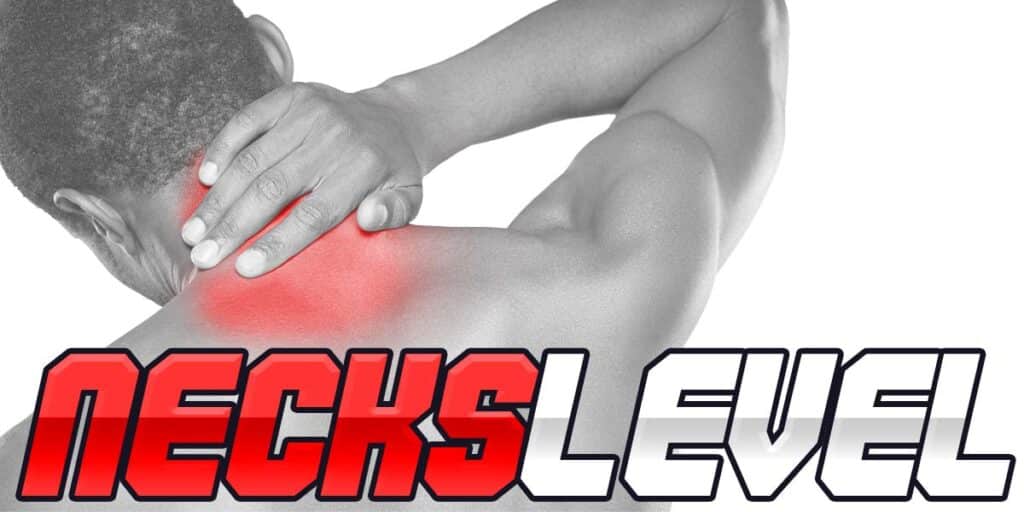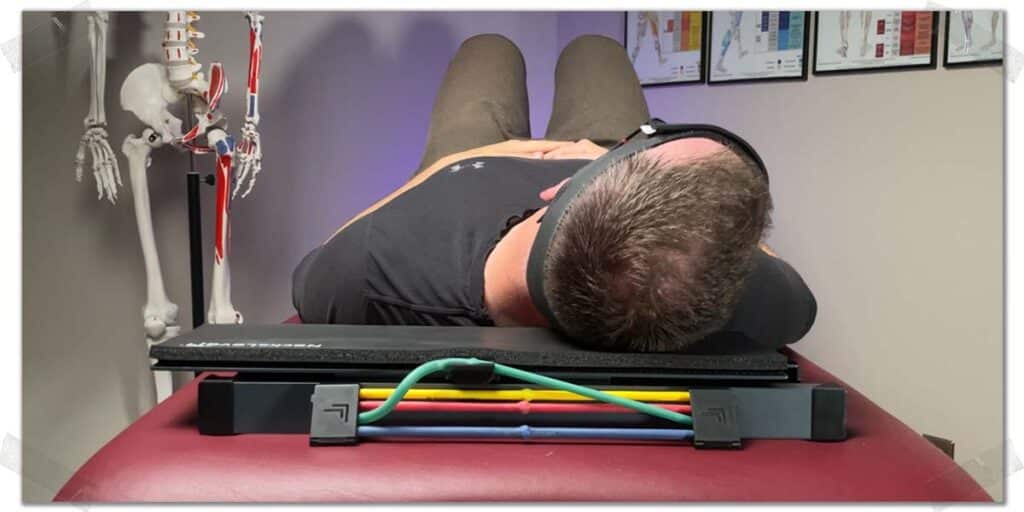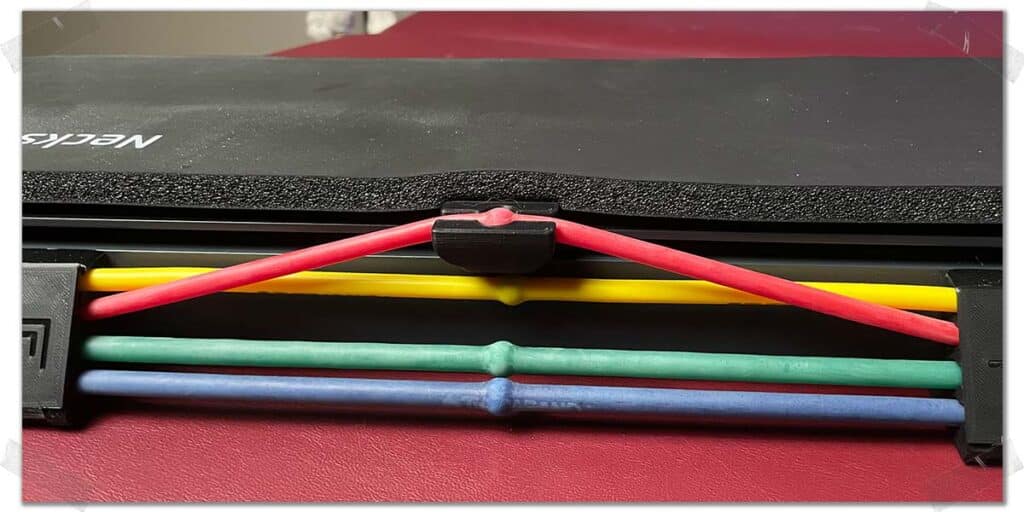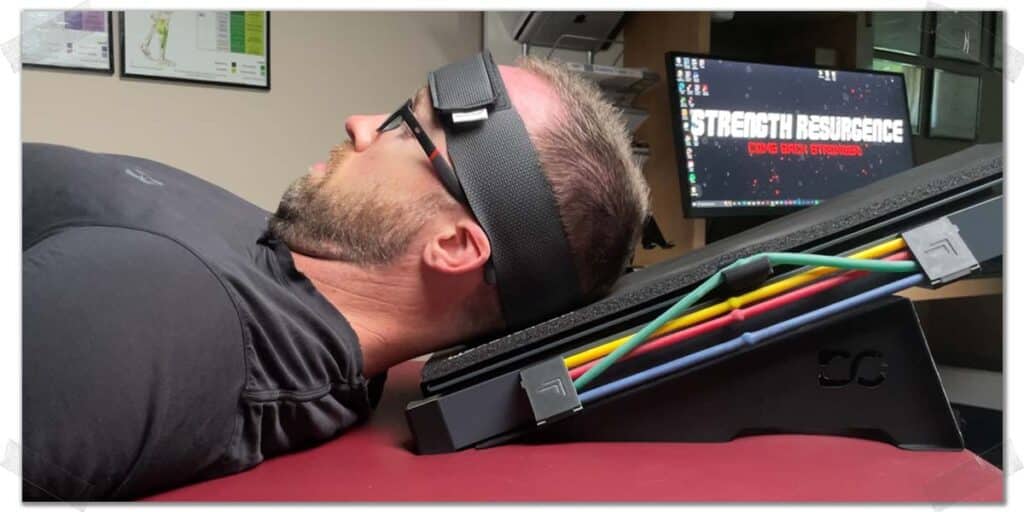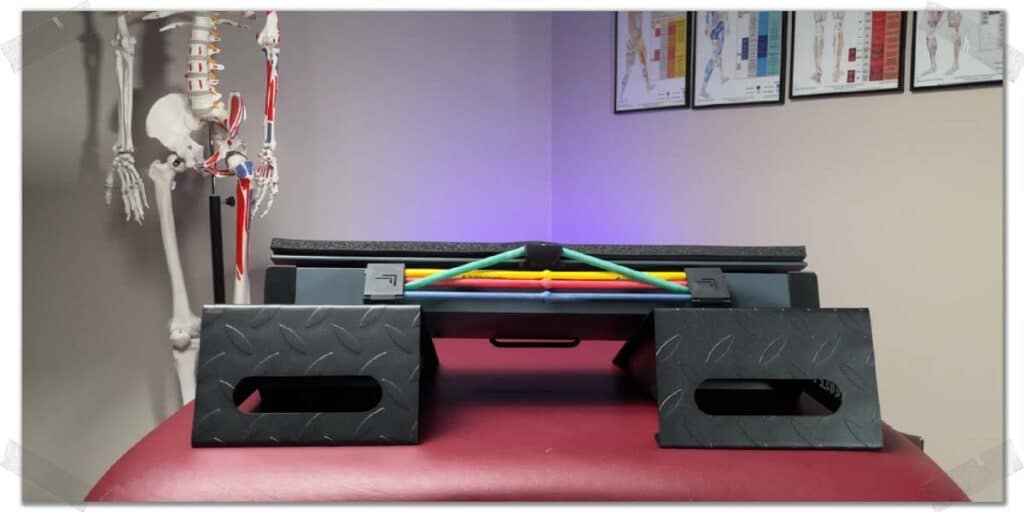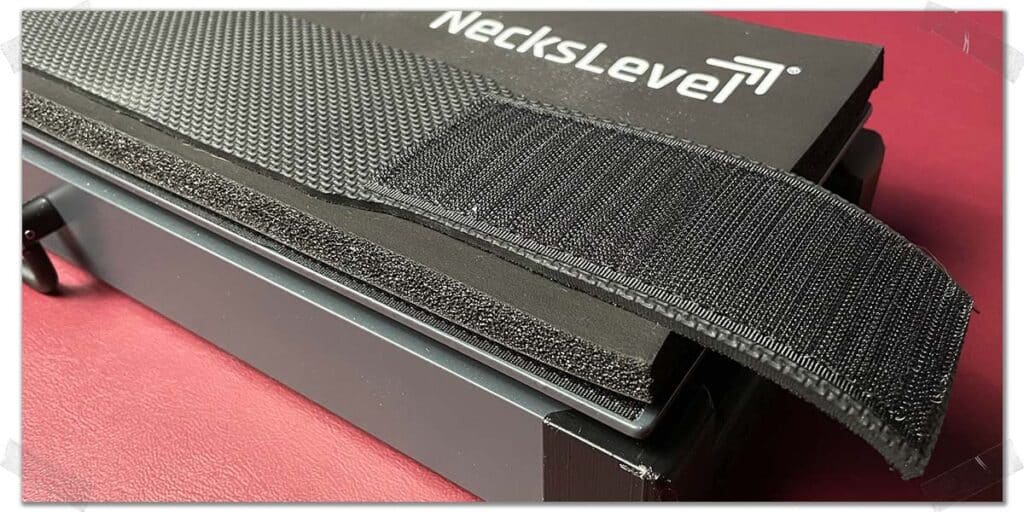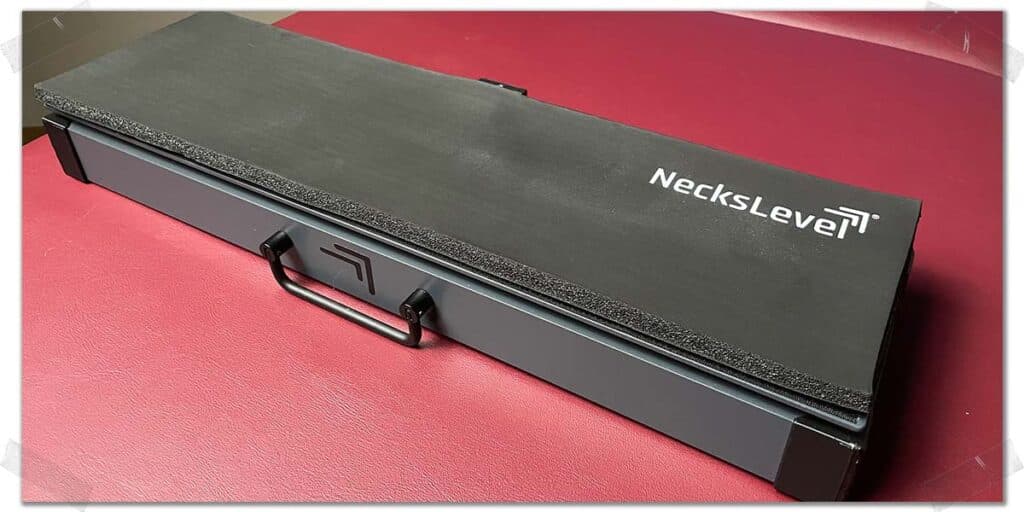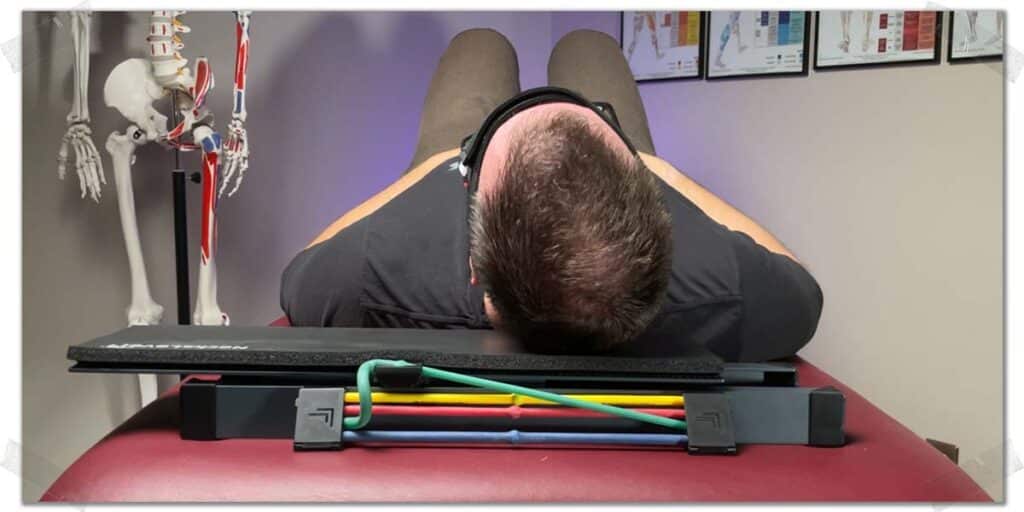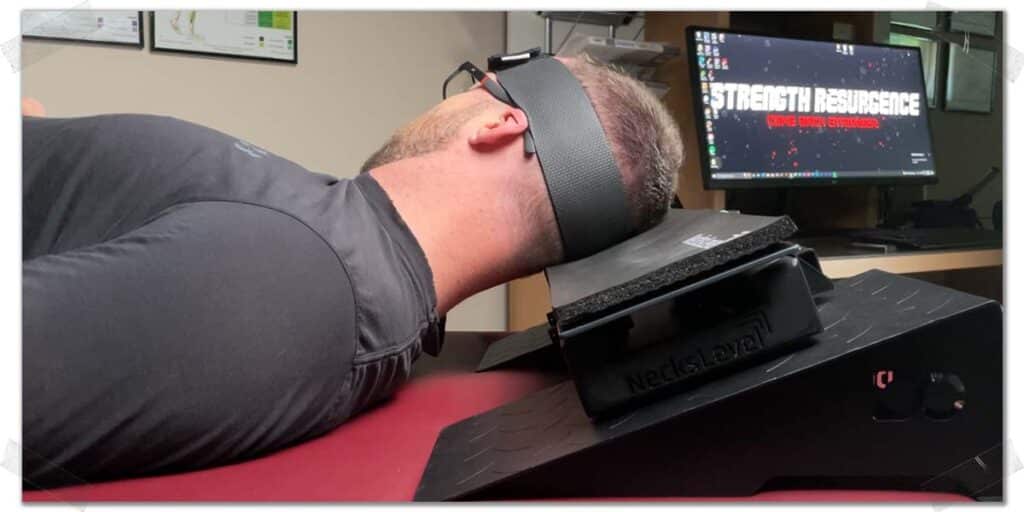Every now and then, I get my hands on a piece of rehab equipment that gives me a feeling deep down inside, telling me that I’m onto something good. It doesn’t happen as often as I’d like, but it sure is a good feeling when it does. I’m all about my patients, so this particular excitement I get is more for their sake than mine; nothing makes me happier than to bring healing to others.
And when it comes to the NecksLevel device, there’s a world of healing that this unique piece of equipment can assist with, provided you know what you’re doing. So, what’s the short answer to this review? Here it is:
The NecksLevel device can be a highly valuable piece of equipment for cervical rehab and offers unique advantages over other neck rehab products. Its overall build quality is on point, and its simplistic, non-intimidating nature makes it ideal for those with various cervical conditions.
Of course, there are plenty of details to unpack here. Still, if you’re willing to read through this article, you will learn valuable information about this device you might not find anywhere else online.
Related article: The Best Way to Stretch Your Stiff Upper Neck: A Physio Explains
Disclaimer: All thoughts and opinions within this article are my own. I do not have any affiliation with the NecksLevel company, and I have purchased the NecksLevel device with my own money, albeit at a discounted price. NecksLevel does not get to see this content before publishing nor provide any input to the article thereafter.
What does the NecksLevel do?
I’ll keep this section incredibly short, as you’re more than likely aware of the general premise of this device. But on the off-chance you aren’t, here’s a quick rundown:
The NecksLevel device is a piece of exercise equipment that has been designed to improve neck function and health, either for injury rehabilitation or injury prevention. It achieves these objectives via acting as a sliding platform with variable resistance (via Theraband tubing) attached.
Cervical spine movements it can target include:
- Cervical rotation
- Lateral flexion
- Upper cervical flexion
Who is the NecksLevel for?
Diving into the meat and potatoes of this article, one of the critical pieces of information to discuss is who this product is intended for. Yes, we are all aware that it’s a device designed to treat various cervical dysfunctions or conditions (more on that in the following section). However, it’s intended to be purchased by healthcare practitioners for clinical use instead of home usage by the average individual.
And this is simply due to the cost of the device. In my discussions with Dr. Scott Dickenson — the inventor of the NecksLevel device — he personally informed me of this. With a starting price point of $895 (USD), it’s simply too high of a price point for the average consumer looking to treat their neck pain.
That being said, Dr. Dickenson informed me that there may be a point in the future in which there will be a NecksLevel device designed for home use. Should this be the case, I’d be incredibly excited to get my hands on it and try it out.
Related article: The Iron Neck: The ULTIMATE Review From a Physical Therapist
Conditions the NecksLevel can treat
A lot of things can go wrong with the neck and its various structures and tissues. While cervical rehab is highly dependent upon each individual case, what follows are generalized conditions or situations for which the NecksLevel device can be implemented for rehabilitative or even prehabilitative (injury prevention) purposes (however, what follows is not an exhaustive list).
Whiplash-associated disorder (WAD)
Whiplash-associated disorder (WAD) is the most common form of cervical dysfunction I treat within the clinic. While I treat plenty of individuals with postural dysfunction (discussed in the next section), and various sports-related cervical injuries, WAD is by far the most prevalent. Most of my WAD patients are from motor vehicle accidents (MVAs), however, I do occasionally see them from sporting-based activities as well.
Whiplash can range extensively in severity, from nothing more than minor aches and pains (WAD I) all the way up to WAD IV. I primarily treat WAD II patients, meaning they have pain and some form of reduced physical capacity in their neck (such as loss of range of motion or strength).
WAD II, in particular, can leave necks in a delicate state and can be disconcerting to patients. Optimizing joint function, muscle tone, and strength are all part of the requisites for returning to normal function. And thankfully, the NecksLevel device can help with each of these facets when used appropriately.
Postural dysfunction
Postural dysfunction is essentially what it sounds like — it’s an imbalance in muscle function between different groups of muscles, which leads to physical impairment, discomfort or pain, and — you guessed it — postural imbalances.
In the case of the neck, postural dysfunction is quite common, especially in those who sit at a desk for multiple hours on a regular basis. While multiple types of postural dysfunctions can arise, the most common within the region of the neck is known as upper crossed syndrome.
Related article: How to Fix Your Posture While Sitting at Your Desk (Five Proven Tips)
With upper crossed syndrome, the muscles on the back side of the upper neck (the suboccipital muscles) become tight, while the muscles on the front of the neck become weak or inhibited. The result tends to be the stereotypical “head foreward, chin up” position we notice in plenty of people around us.
Pro tip: “Text neck” is another common neck condition that has been coined to describe the postural position, pain, and discomfort that often arise from the prolonged head-forward position individuals often go into when performing activities such as reading on their cellphone or typing messages.
Postural dysfunctions can lead to reduced ranges of motion, reduced functional strength, and pain and discomfort in the neck. As such, the muscular dysfunction it creates should be addressed appropriately.
The NecksLevel device shines brilliantly when treating postural conditions such as these (which you’ll see in some of the exercises below). It’s remarkable how weak or inhibited some of these muscles can become; you never really know just how affected they are until you start using the device.
Generalized weakness
When it comes to strengthening all the parts of the body, the neck is all too often neglected. Everyone trains their arms, legs, and core, but how many people do you know who genuinely train their necks?
It should come as no surprise (it certainly doesn’t to me) that many individuals — young and old — lack adequate strength and endurance within their neck muscles, even when they haven’t had any injuries or trauma to their neck.
The problem with generalized cervical weakness is that:
- It can lead to an increased likelihood of injury
- It can lead to discomfort or pain
- It can adversely affect the function of other muscles
- It can adversely impact one’s ability to perform activities of daily living
Yes, other devices or methods of neck strengthening are available (such as traditional neck harnesses). Still, they either aren’t often appropriate for very early stages of cervical rehab following traumatic injury, or they require the patient to be in an upright or non-supine position, which can add complexity or discomfort to the overall exercise.
Now, I need to make it clear here that I will often use other such neck devices either when in later phases of neck rehabilitation or when taking a prophylactic (injury-prevention) approach with those who already have otherwise healthy necks. As always, it all comes down to the individual patient and their overall condition.
But I should also mention that the NecksLevel can absolutely be used for some of these injury prevention situations as well, albeit perhaps a bit limited. The points I’m trying to make are that:
- The NecksLevel is my absolute go-to neck device until my patients either: feel comfortable progressing to additional interventions or they demonstrate the functional capacity or capability to do so.
- This device can still hold a time and place for injury prevention with certain individuals on my caseload.
Strengths of the NecksLevel
The NecksLevel device may look relatively straightforward to use (it largely is for the most part — which is, of course, a good thing), but don’t let that fool you into thinking it doesn’t have some seriously profound benefits that make it stand out from other neck strengthening devices. Let’s look at a few of them.
Early-stage cervical rehabilitation
Early stages of neck rehabilitation often require gentle movements (strengthening-based or otherwise) while maintaining maximal control at all times. What makes the NecksLevel so incredibly ideal for early-stage rehab is its ability to use incredibly light resistance while allowing the individual to focus solely on their neck without simultaneously needing to focus on posture or balance.
By allowing the individual to rest their entire body (laying on their back) while producing neck movement, it’s much easier for the brain to focus on, feel, and interpret the positions, movements, and sensations that are taking place in the neck.
This phenomenon is known as sensorimotor awareness, where the brain interprets and feels how movement is occurring within a given body part. Improving sensorimotor awareness is a critical component of cervical rehabilitation after injury.
It’s analogous to running a computer program with multiple other tasks taking place in the background; the more background tasks are going on (i.e., balance, posture, etc.,) the less the CPU (i.e., the brain) can dedicate to processing and interpreting what’s happening with the neck itself.
Pro tip: I often have my patients close their eyes while performing exercises on the NecksLevel device. Not only can this help them to feel and interpret their neck movement to a better extent, but it can also help reduce sensations of dizziness or nausea they may experience if their cervical proprioception is poor.
Unlike other neck exercises or strengthening devices that require you to be in a standing or upright position (which absolutely has a specific time and place), the NecksLevel affords the unique ability to concentrate solely on feeling and interpreting movements and positions of the neck when using the device. This feature can provide a critical step forward in successful cervical rehabilitation.
Complete control of the movement
Again, with early-stage cervical rehab, there’s little room for surprises regarding unexpected movement. With early-stage neck rehabilitation, one sudden unexpected move or wrong movement can flare up the neck, leading to unnecessary pain and recovery setbacks.
With the NecksLevel device, there’s essentially zero risk of experiencing sudden, unexpected movements (often called perturbations) to the neck when using the device.
Non-intimidating in its appearance
It may sound like I’m making a stretch for finding strengths of the NecksLevel, but this is absolutely not a stretch at all; many patients (especially those who are in pain) or unfamiliar with physical therapy interventions can become easily intimidated by other pieces of neck strengthening equipment or therapeutic modalities within the clinic.
The patient always has the right to refuse a particular type of treatment or device if they’re uncomfortable with it for any reason. I’ve had this happen when asking patients if they’d be willing to try other neck strengthening devices I often use or other therapeutic modalities that may be of benefit. Whether it’s the fear of the device itself or the fear of “looking silly” while using it, sometimes patients won’t opt for specific neck strengthening interventions.
This is one of the biggest stumbling blocks I run into when using the Iron Neck Pro on my patients. Don’t get me wrong, I love this device, and I have plenty of patients who absolutely love it and swear by it as well. Still, I have a handful of those who are intimidated by how it looks or don’t want to “look silly” while wearing it in the clinic.
The NecksLevel device is about as non-threatening as it comes. Patients can easily see how it works and feel at ease knowing all they have to do is lay on their back when using the device. And while I might have to give some verbal cueing to the patient in order to optimize their technique, it generally takes much less than with other neck devices since the patient is lying flat on their back when using the device.
What’s even better is that it can be used virtually anywhere; it doesn’t need to be hooked up to any external equipment or objects, and it can be utilized on a treatment table or plinth. This is the cherry on top of an already rather sweet piece of therapeutic cake.
Build quality
I’m always a stickler when it comes to the build quality of a product; I believe that every company should take pride in what they produce and that every user should feel like they’re getting their money’s worth.
The build quality of the NecksLevel device is on point, and I don’t have any complaints.
As I’ve said in my other reviews, I never feel comfortable talking about my expectations of price points with products. I’m just a physical therapist; I have no idea how much time and money it costs to research and develop physical products or the various other expenses that must be factored in, of which I’m unaware.
As such, I’m in no position to critique the price point of the NeckLevel device. Do I wish it were less expensive? Of course. But do I also wish every other expense in my daily life were less as well? Absolutely. I’m not sure what makes the device cost as much as it does. Still, I’m going to assume in good faith that it’s priced fairly based on the R&D and other costs associated with this device’s production.
So, I can say that the device’s quality is certainly up to my expectations. The materials are great, the sliding is buttery smooth, and it’s an all-around very comfortable experience to use the device. It’s also nice to see that replacement parts are available (such as the Theraband tubes and the foam pad) for when the time to replace them comes.
Some of my favorite exercises
The NecksLevel device affords a surprising amount of exercises and movements, more so than what the average individual might be aware of. What follows below are some of the exercises I’ve been having good success with when using the device on myself and on my patients:
Cervical isometrics
Cervical isometrics are one of the initial exercises I’ll use for many of my patients. I often use this as a way to “tune in” or get a “status check” for how their neck feels when activating muscles that might not be in an ideal or healthy state. Often, I find that patients quite enjoy the sensation of feeling these muscles “wake up” and have to work while also noticing that certain sides or areas of their neck are working a bit harder, tire out more quickly, or generally feel tighter.
Eccentric rotations
The eccentric rotation is another exercise that I’ll incorporate early on in the NecksLevel implementation. Not only does it help patients to feel the overall status of their neck, but it also affords me the ability to look at their motor control or movement quality while eccentrically rotating.
The quality of their rotation can help me better understand the overall condition of their neck; I’ll often find patients with weak musculature, stiff necks, or poor motor control tend to produce rather jerky eccentric motion. In contrast, those with overall healthier necks can produce a much more smooth or fluid motion.
Upper cervical rotation bias
When it comes to targeting specific areas of the neck, many of my patients need some extra emphasis on the upper portion of their neck as opposed to the middle or lower portion. When it’s appropriate for them, I’ll often place the NecksLevel device on my squat wedges, which will place the patient’s neck into a bit of a flexion bias when restin their head on the board.
As they perform some of the basic movements, they’ll often feel a bit more muscular engagement or effort occurring in their mid-upper neck. This can be highly beneficial for these individuals, and is therefore one of my favorite ways to hone in on the mid-upper neck using the NecksLevel device.
Professional opinion
In case you couldn’t tell by this point, I’m quite a fan of Dr. Dickenson’s NecksLevel device. There simply isn’t any other device on the market (at least, that I’m aware of) that can target, activate, and strengthen the muscles of the neck for early and mid-stage rehab the way the NecksLevel can.
Its practicality, portability, and non-threatening nature can lead to noticeable improvements in the function of patients’ necks for strength, range of motion, and pain reduction. Yes, there are additional therapeutic adjuncts and devices that can assist (and should often be used in conjunction with) neck rehabilitation.
Still, for early-stage activation, strengthening, and even sensorimotor awareness, the NecksLevel device would be one that’s hard for me to live without now that it’s opened up new doors for how I treat necks.
Final thoughts
For orthopedic clinicians, the NecksLevel device is a highly valuable piece of equipment to have on hand. For many cervical patients, it’s a device they can absolutely benefit from, albeit from within the clinic (it’s generally too expensive for home purchase). I’m excited at the prospect of a home-use version potentially being created.
As for the current device, it checks all the boxes for what a therapeutic device should offer: functional, versatile, effective, and practical. As a result, it can open some highly valuable doors for treating various cervical conditions within a clinical population.
Props to Dr. Dickenson and the NecksLevel team for coming up with this outstanding device.

Hi! I’m Jim Wittstrom, PT, DPT, CSCS, Pn1.
I am a physical therapist who is passionate about all things pertaining to strength & conditioning, human movement, injury prevention and rehabilitation. I created StrengthResurgence.com in order to help others become stronger and healthier. I also love helping aspiring students and therapists fulfill their dreams of becoming successful in school and within their clinical PT practice. Thanks for checking out my site!

